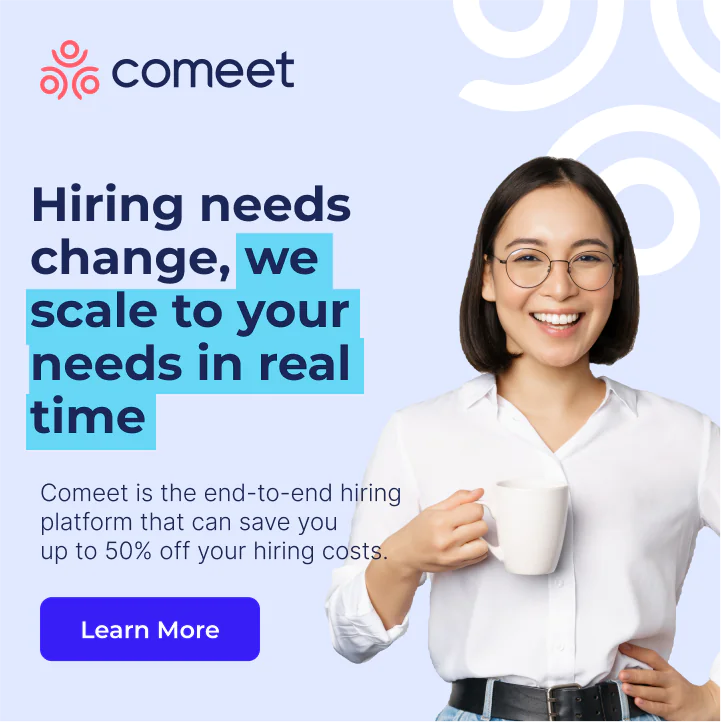Are you planning on creating an employee referral program (ERP) but unsure where to begin? A lot goes into making it successful, but starting an employee referral program has many benefits and adds tremendous value to your business. That’s why 82% of companies have already integrated the program into their recruiting process. It’s also why your business should make the integration as soon as possible to compete in an environment experiencing a 16-year high in talent shortage reports.
Whether making updates or starting from scratch, here are our top tips and benefits for creating an employee referral program that works.
The Benefits of an Employee Referral Program
Mark Zuckerberg, founder and CEO of the successful social media platform Facebook, once said, “people influence people. A trusted referral influences people more than the best broadcast message. A trusted referral is the Holy Grail of advertising.” And we couldn’t agree more! You see a similar concept with customers: customers trust other customers over the brand itself. And just as word-of-mouth from a customer is about as good as it gets, so are word-of-mouth referrals from your team members.
Here are some other benefits you’ll experience:
- Improved retention rates — employee referrals boost retention by 46%
- Employees stay with the company for longer — 45% stay for more than four years compared to just 20% sourced from job boards staying for more than two years
- Faster time to hire — hires are most often within 29 days compared to the average 39-55 days from job sites
- Cost less than traditional recruitment strategies — 55% of companies find it to be more cost-effective to hire through referrals, with the average cost reaching $4,129 per hire
- Better quality candidates and hires — new hires through referrals are 350% less likely to get fired
- Boosts employee morale — when employees feel like their opinion is trusted and valued, they feel more connected to your company
- Referred hires fit company culture and core values better — according to 70% of businesses
Factors to Consider When Developing an Employee Referral Program
After you’ve gotten management on board by discussing employee referral programs and their importance to the company, there are some significant factors to consider as you develop your program.
Define your program goals first
Every successful program begins with well-defined and clearly stated goals. The benefits include providing direction for your team members, setting a clear focus, informing current & future decisions, and laying the foundation for choosing the proper methods and incentives for reaching that goal(s). A framework such as SMART (Specific, Measurable, Attainable, Relevant, and Timely) or similar is often preferred since it can help detail your goals as much as possible.
A good example is this one from Oberlo:
“I’m going to help my team land more sales” versus “I will lead my team to improve our qualification process so that the team only calls high qualified leads that are likely to purchase. We aim to increase sales by 5% within three months.”
Be very clear in your guidelines & expectations
After you’ve determined who is eligible to make referrals and what you expect from the employee and their referred candidates, state it clearly in your guidelines. Ensure employees are aware of the roles you want to fill and the ideal candidate for each position. This will help employees connect you with the right matches instead of guessing what you need.
You must also differentiate between rewards—i.e., incentives for employees that refer candidates to entry-level job openings versus executive. In fact, the Society for Human Resource Management (SHRM) reports that 78% of businesses give the same reward for a referral no matter the open position (executive, entry-level, and everything in between). However, having tiered rewards for the hiring level ensures you’re rewarding employees for their contribution while better incentivizing the higher levels that require a higher grade of expertise, talent, and experience.
Offer incentives your team would find valuable
There are dozens of incentives you could implement into your program: cash rewards, days off, additional vacation time, gift cards, merchandise, happy hours, travel rewards, paid lunch, etc. The possibilities are endless, and more importantly, they vary by the quality and level of the referral.
Incentives are a great way to motivate your employees to refer qualified friends and networks to your open positions. However, they won’t be motivated if they’re not directly linked to the interests and needs of your employees. While it can be helpful to look at what other companies are doing to inspire your ideas, you must also ensure it encourages your team to participate.
We recommend first asking your staff members for feedback on rewards and incentives that would motivate them. After all, who knows what rewards would incentivize them more than the people you’re trying to reach?
Continuously evaluate and make updates (request feedback!)
As your business scales, your staff evolves, and times change (take, for instance, the impact of the pandemic), you’ll need to consider your referral program and ensure it’s still suitable for your team by updating the following:
- Guidelines
- Expectations
- Eligibility
- Submitting process
- Rewards/incentives, etc.
The best place to start is with the people you’re trying to attract: your employees. Ask for their feedback on what they would like and any improvements they recommend after going through the program. More importantly, listen to what they say and implement their recommendations.
Give recognition and credit
When it’s all said and done, you must always give your employees recognition for matching you with the right candidate for the position. Team members expect credit for the hire even when incentives are on the table. A silent reward is nice, but people also like to hear how valuable they are.
According to Gartner, more than 50% of people seek more value and purpose at work. Voicing recognition and credit is one way to ensure your team members achieve that value and purpose in their positions and, therefore, are less likely to look elsewhere for it.
How to Communicate the Referral Program to Employees and Encourage Participation
Communicating the referral program to your employees to encourage participation is always important. It isn’t something you want only to make a priority in the beginning, then leave it up to them to remember down the line. It’s also not something you mention once or twice a year.
Here are four ways you can ensure your ERP is top-of-mind all year round:
- Use internal communication and resources — email, instant messaging, company newsletters, meetings, presentations, etc.
- Establish a routine for reminding staff about ERPs — for instance, voicing the reminder before every meeting or sending a thorough email every Monday.
- Post your referral program on social media and make it sharable — many team members follow their companies on social media (particularly LinkedIn). This could be an excellent opportunity to remind staff of the referral program while making it easy to share so they can pass it along to potential candidates.
- Keep employees posted, even if their candidates didn’t proceed to the next step — your team members deserve to hear how the referral process is going after submitting. Remember ALWAYS to say thank you to them for submitting, even if the referral didn’t make it into the role.
3 Tips for Creating a Successful Referral Program
Not just any referral program will generate the results you’re looking for. However, these three tips will help you avoid mistakes many other companies make so your program will be more successful.
1. Make the referral process as smooth & easy as possible
More often than not, companies add too many rules and stipulations in their referrals. If the process is too time-consuming and complex to complete, you risk losing out on some of the top candidates for your open positions. Instead, make the process as smooth and easy as possible.
This will ensure your team is driving candidates to your HR department, where they will do what’s required to narrow down potential hires and locate the right fit. Your employees expand your candidate reach—it’s still up to your HR team to ensure they’re the right hire for the role.
2. Dedicate the appropriate resources to your HR team
Another mistake too many companies make is not having the resources available within HR to keep up with referrals. Losing referrals and employees not hearing back with a response can damage your initiative. After all, what employee will allocate their precious time to help the company connect with quality hires if it could be all for nothing anyways (despite the candidate being right for the role!)?
We recommend that you:
- Implement a reliable strategy for accepting, recording, tracking, and responding to employee referrals (an all-in-one hiring solution can help!)
- Hire more HR team members if the extra hands are needed
3. Don’t limit referrals to only when you’re hiring
Finally, don’t halt referrals just because there aren’t any job openings to fit the recommended candidate. Not only are 23% of people planning on quitting in the coming year, but there are various unforeseen reasons why a position may unexpectedly open up (i.e., accidents, early retirement, personal reasons, etc.).
It can be helpful to have a quality candidate in the back of your pocket when it happens. You may even find that you can’t pass up on the quality hire either way. Kevin P. Ryan, an American investor and entrepreneur, once said, “I heavily overinvest in recruiting. I have an understanding with certain search firms that if you find someone great, don’t wait until there’s a job opening—send [them] to me.” Considering his success with multiple New York companies, the advice is worth considering.
Most Popular Referral Program Ideas
To inspire the success of your employee referral program, here are two popular ideas you may want to consider during the development process.
A point system
A point system allows employees to be rewarded for every effort they put into referring a friend to the company—not just a bonus after a predetermined period the new hire was with the company. This typically includes getting about 1000 points for simply submitting a referral to the program (1000 points = $10). Another 1500 points (now 2500 points, equaling $25) may be given to employees whose candidates make it to an interview. Pints may also add up for qualities you find mandatory or nice to have, such as speaking more than one language, having special rewards or certifications, being open to travel, etc.
The point system varies from company to company, but the concept is the same: employees are regularly incentivized to submit referrals. In turn, their points add up to cash value, and you have a regular stream of talent to consider.
Social recognition
Being recognized by management and co-workers is becoming more important by the day, especially when employees do something as significant as filling open positions with qualified and compatible candidates.
These gestures can range between small and large, with some favorites including the simplest of actions: encouraging peers to pass along a ‘thank you’ in the hallway and giving a shoutout during meetings.
Company awards ceremonies
Often accompanied by a great meal, drinks, and hors d’oeuvres at a nice place, company awards ceremonies are a great way to bring everyone together and recognize your staff for their incredible work. These ceremonies aren’t limited to employee referrals, either. They’re an opportunity to recognize your employees for various significances: employee of the month, quarter, or year, top performers, team players, work anniversaries, etc.
That said, adding recognition for employee referrals is important because it’s a chance for team members to feel appreciated by both the company and their peers simultaneously.
When it comes down to it, almost 50% of businesses report their highest-quality hires as employee referrals. In an environment of mass quits and difficulty filling positions, there isn’t a strategy your business can afford to miss out on. Contact our team at Comeet to discuss your recruiting needs and how we can help you fill positions faster.





























